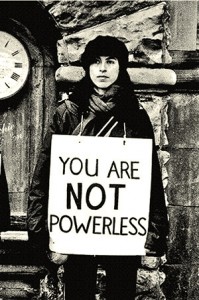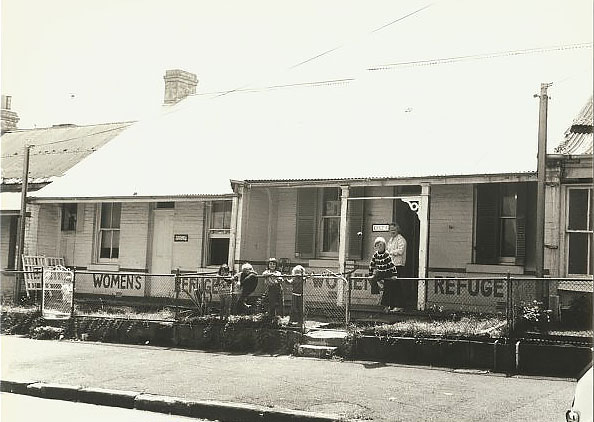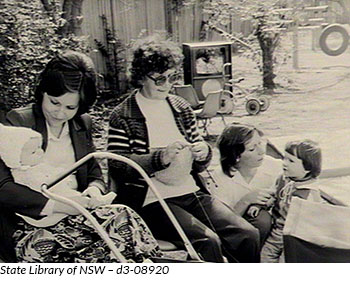Our Long History




The story of Bonnie’s
Bonnie’s was started as a women’s refuge way back in 1975 by a small group of women who wouldn’t take ‘No’ for an answer. They were trailblazers for women. Bonnie’s was the second refuge ever established in Australia.
When we started, Australia was a very different place for women. Public policy and opinion were skewed against them in ways that are almost impossible to imagine now.
> The contraceptive pill carried a 27% luxury tax
> Abortion was illegal except for health reasons
> Women were paid only 75% of the male wage
…there wasn’t much awareness of domestic violence or an appreciation of what it was. There was almost an attitude of, ‘You must have asked for it’.
Christine Sykes, volunteer
In those days, a woman’s place ‘was in the home’, regardless of what that home was like. Or how dangerous it was. Domestic violence was largely a shameful secret, not even acknowledged in legal or medical records. Women were traditionally made to feel responsible for domestic violence against them.
Many women and their children were forced to stay in unsafe situations because they had nowhere else to go. There was no supporting mother’s benefit and no refuges or crisis accommodation. The situation for homeless women was just as difficult with only very limited places within homeless men’s hostels available to them.
Women were trapped: physically and financially. The only real options were to flee to a neighbour or other family members. Or try to hide out alone.
How did change happen?
 It was called feminism. This was a rise in consciousness that demanded social change for women and equal rights. It was happening all over the world. Women were protesting on the streets and on university campuses. They were meeting in lounge rooms, cafes and town halls.
It was called feminism. This was a rise in consciousness that demanded social change for women and equal rights. It was happening all over the world. Women were protesting on the streets and on university campuses. They were meeting in lounge rooms, cafes and town halls.
The more women met and discussed the inequality, the more they were emboldened to make things better and fairer for their ‘Sisters’.
A new type of women’s movement was emerging in the Western suburbs of Sydney too. It wasn’t exactly bra-burning feminism but it was informed by the same growing awareness of the problems facing women.
In 1974, a few ‘inner city feminists’ joined a group of local Western suburbs women to discuss what needed to be done. They met for the first time in Green Valley. The establishment of a refuge and a woman’s health centre were top of the priority list.

“There was a strong sense of camaraderie. The conversation was mainly around health and domestic violence. Everyone in the room had been subjected to, or knew someone affected by, domestic violence. There was a strong feeling that we just had to do something…” Christine Sykes, volunteer (a Cabramatta girl)
The first women’s refuge in Australia, Elsie, had just opened in Glebe. It was staffed by volunteers who provided inspiration and advice. Bonnie’s was soon to follow. The prime movers in the Bonnie’s story were Susan Varga, Kay Ferrington, Joan Killorn, Betty Pybus and Edith Warburton. Other women who were crucial include Christine Sykes and Diane Powell. They met and discussed and planned. There was urgency and energy.
Photo: Courtesy Drusilla Modjeska. Elsie Women’s Refuge, Glebe, 1974. National Library of Australia vn3997705-v.
The group became very vehement and very strong in a very short period of time… they had definite ideas of what they wanted.
Women’s Liberation Newsletter, February 1975, page 15
“It was so obvious that we needed to have a women’s refuge in the area. It wasn’t even discussed too much. We needed a house and one way or another, we’d run it.” Susan Varga
The women used all their available networks and powers of persuasion to secure a house that would serve as a refuge. No stone was left unturned with family connections, local council and the government all being called upon.
Support came from men and women in the local area and included influential figures. Diane Powell’s father was well-connected through his position at Fairfield Council. Prime Minister Gough Whitlam and his wife, Margaret lived on Albert Street, Cabramatta. This was just down the street from where Christine Sykes grew up. The Whitlams keenly supported women’s causes.
The first Bonnie’s was called Bonny
In the first weeks of 1975, a request to the NSW Housing Commission to provide a house for crisis accommodation was miraculously approved. This resulted in the setting up of ‘Bonny Women’s Shelter’, as it was then known. Susan Varga, one of Bonnie’s original founders, tells about the role played by a woman named Edith Warburton.
“Edith worked for the Housing Commission. She was in some ways a straight laced person: she was English and originally in the airforce I think. She was a feminist in her own way. We became friends and she became involved and I said to her ‘Edith, you know this area very well indeed. We need a house. Can you get us one?’
“She pulled it off. I don’t know how she did it. She just sprung it. We had the run of that house, one way or another.”
Susan remembers those first days when the volunteers rushed to get the blue cottage at 260 Burns Road, Bonnyrigg ready to open its doors.
“We had to occupy the place to make sure it was ours… We camped there a week or so while we got organised. I remember sleeping on the floor while we scrounged around for beds and the rest of it.”
The shelter was named after the suburb and was in line with the new tradition, set by Elsie, of calling shelters by a woman’s name. It was set up as a collective of women and run by volunteers. Decisions were made collaboratively, and there was (mostly) a strong sense of harmony.
Individuals responded with food, clothing, physical work, time and interest.
Carol Chapman, Bonny Support Group, 1975
“Collectives can be difficult to control, of course.” Christine Sykes recalls. “I remember there was a great deal of disagreement when one of the volunteers insisted on bringing her very big dog!”
The management committee was involved in working bees, scrounging household items and mustering support from local organisations and individuals.
“Please, please help. We need you…”
The Smith Family provided the first furniture while calls for other donations and support went out through newsletters like this one…
Bonny is small – 3 bedrooms, 1 small room to be converted into a bedroom, a small kitchen, reasonable lounge/dining room, sheds at the back that can be cleaned and fixed up to become a play and sleeping area for the kids, a chicken coop, enough room for a vegetable garden, a pan toilet. We have fourteen beds and could build a sleep-out on the back. We have basic furniture but we need a washing machine and an extra refrigerator.
Are there any students/interested women who could help us out for a month or two by being a live-in, part-time administrator? This would bridge the gap until we get a roster better organized and/or get some money.
We’ve got a real chance of getting a Women’s Shelter going in an area where it is desperately needed. We need the help and skills of lots of women.
from Women’s Liberation Newsletter, February 1975, page 15
We knew that if we had a house and we could people take in, they would come. And they did. It took off very quickly.
Susan Varga
The aim from the outset was to create a safe and welcoming space for women that felt like a home, “where the women are encouraged to participate in the full running of the household”. This was achieved despite the fact that money was scarce.
In 1975 the Whitlam government began funding health and welfare services for women. This included a $250 International Women’s Year grant for Bonnie’s Women’s Shelter. In its first six months of operation, thirty women and their children were given temporary accommodation, friendship, counselling and time, away from domestic conflict, to plan their futures.
Life at the shelter
 Empathy and friendship have always played a central part of life at Bonnie’s and life inside the refuge is remembered as often surprisingly fun.
Empathy and friendship have always played a central part of life at Bonnie’s and life inside the refuge is remembered as often surprisingly fun.
I remember a day when somehow or another, we got a whole lot of shoes donated. There were a dozen or so of us, all sitting on the floor of the lounge room. There we were, the volunteers and the clients, scrambling through this big pile. It was just hilarious with kids clomping around in enormous boots and high heels; and some of us pretending to squabble over shoes that were so ugly, none of us would have wanted them.
I was a bit embarrassed about showing my feet because I always felt they were too big but excitement got the better of me and I peeled off my sandals to try on a pair of black shoes. (They fitted perfectly.) But when I went to find my brown sandals again, my favourites, they were gone! That’s when I saw that one of the clients had them on. She was parading them for the others, thinking they were part of the pile. She was very happy with those sandals and they fitted her perfectly too. I remember she was new and was still carrying the bruises and cut lip from the night she’d fled home.
I had to tell her they were mine (we were all broke then!) and we had a good laugh about it. But all these years later I still remember it. I remember thinking, ‘Oh my god, she’s got the same big feet as me!’ We were literally walking in the same shoes. We were just two women, different circumstances but also the same.’
Christine Sykes, volunteer
Funding at last
A funding cheque for $9,500 arrived on 20 June 1975 and Bonnie’s was able to relocate to Liverpool. We remained there for eighteen months before shifting to a day nursery in Cabramatta.
The next few years were filled with short term solutions and big plans for a permanent home and a move from volunteers to professional support workers.
In 1979, Fairfield Council made land available on which a house could be built. Janice Crosio, the Mayor of Fairfield at that time, was a key supporter. With help from the state department of Youth and Community Services and Federal Department of Health, a permanent home for Bonnie’s was established.
In 1986, Bonnie’s became incorporated as a public company and in 1992, due to the demand for services, a second house was built alongside the first. Bonnie’s still operates from these two properties today.
Over the next three decades, we continued to expand our range of services to women and their children. We are now known as Bonnie Support Services Limited and we are a Registered Community Housing Provider (CHP). We are staffed by highly trained women from diverse backgrounds. We have two supported crisis houses in the Fairfield area and 30 transitional properties. Our support services and accommodation assistance work side by side.
Our story continues…
Nearly 50 years ago, a group of women took it on themselves to join with the local community to create safety and possibility for others. Over the decades that have followed, many other women have played a crucial role in continuing that story. Today, Bonnie’s is an enduring service that is unique in Australia. A service that is By Women and With Women.
Bonnie’s thanks and celebrates all the women over the years: the founders and volunteers and clients and staff, who just wouldn’t take ‘No’ for an answer. And we salute the women who can now build better lives because of them.
For women in Western Sydney, many things have changed for the better since we first opened our doors. But there is still so much work to be done to provide women who are escaping domestic violence and homelessness with choices and support. Bonnie’s can continue to do more with your involvement.
Join our story by donating to Bonnie’s now…
Bonnie’s founding women
Local women were joined by activist women from the inner-city. In the original funding proposal for Bonnie’s, these are the women who are listed as the prime movers. The Committee had been in existence for only 5 weeks when they wrote the proposal asking for support with an annual budget estimated at $51,100.00 (Oh, those were the days!)
Jill Farraway. Age: 47. Lived: Sadlier. Children: 4. Sponsor for Al-Anon.
Kay Ferrington. Age: 40. Lived: Miller. Children: 5.
Kay was extremely interested in local politics and was acutely aware of the harsh reality of many women’s lives in the western suburbs of Sydney. As well as being a co-convener of the Green Valley Women’s Group, Kay was a founding member of the Women’s Health & Resources Foundation Ltd and went on to play key roles at Liverpool Women’s Health Centre.
“…living in this area I became aware of the problems facing a great many women who are existing, rather than living, and who need to find their own direction to a fuller life.”
June Howman. Age: 39. Lived: Miller. Children: 3.
June Howman became involved with Bonnie through her interest in local affairs.
Joan Killorn. Age: 45. Lived: Green Valley. Children: 6.
Joan was actively involved with church and community groups. She was Assistant Director of Green Valley Video Access Centre for 6 months prior to her joining Bonnie’s cause, when she became a key initiator.
“Through involvement with people in the area, I realise the urgent necessity of such a Centre and am prepared to work tirelessly to achieve it.”
Joan Lott. Age: 45. Lived: Busby. Children: 3.
Like many others, Joan drew on the wisdom gained from her own experiences to reach out to women in need.
“Incidents in my own life made me believe I could be of help to women using the centre.”
Connie Peters. Age: 39. Lived: Liverpool. Children: 3.
Connie was especially interested in social justice for the disadvantaged as well as women’s issues.
“I am concerned about the lack of sources of help for women and girls whose home lives have become intolerable.”
Marion Pickard. Age: 24. Lived: Annandale.
Marion was a psychologist at Liverpool Area Health Centre as well as an active member of the A.L.P. She had a longstanding interest and involvement in women’s issues.
Valerie Florence Mary Thomson. Age: 40. Lived: Liverpool area. Children: 7
Valerie was actively involved in the Women’s Health and Resources Centre and the Liverpool Valley Lion’s Club, of which her husband was Charter Treasurer.
“I feel from past experience in my own life and family, that there is a serious need for facilities of this type in the community and through my experiences I may help someone from making the mistakes I made.”
Susan Varga. Age: 20s. Lived: Birchgrove.
Susan Varga was a teacher, writer and filmmaker who became director of the Green Valley Video Access Centre in April 1974. She was strongly connected to the community through her work in film and community video. Susan was one of the makers of the film ‘Home’ about the problems of young girls in State Institutions. Her abiding interest in women’s affairs led to her involvement at Bonnie along with Elsie Women’s Refuge, Leichhardt Women’s Community Health Centre and Liverpool Women’s Health Centre.
“I am enthused by the strong involvement of women in Liverpool – Green Valley in the establishment of this centre and am committed to working for it. I have also great confidence in its potential success.”
Members of the consultative committee
Betty Pybus. Lived: Mosman.
Betty was an accountant who was committed to improving the lives of women. She had a lifetime involvement in community affairs and was an advisor to many prominent women’s groups.
Beverly Garlick. Lived: Leichhardt.
Beverly Garlick is a Sydney architect who was a member of the Bonnie Consultative Committee and the Executive Committee of the Women’s Health and Resources Foundation.
Edith Warburton. Lived: Ermington.
Edith was a Senior Welfare Officer at Housing Commission N.S.W. She had been a policewoman in the Manchester City Police Force and a Sergeant in the Royal Women’s Air Force in both England and abroad.
Bonnie’s was established through a grassroots push that was fostered by a diverse group of advocates. At the time, there was a great deal of support for women in the area from local politicians and community groups. These are some of the local people and organisations who supported the establishment of Bonnie.
- The Green Valley Community Centre
- Video Access Centres – Valley Video and Fairfield Community
- Fairfield City Council
- Rotary Club of Cabramatta
- Janice Crosio – Alderman and Mayor, Fairfield City Council
- Les Powell – Mayor, Fairfield City Council